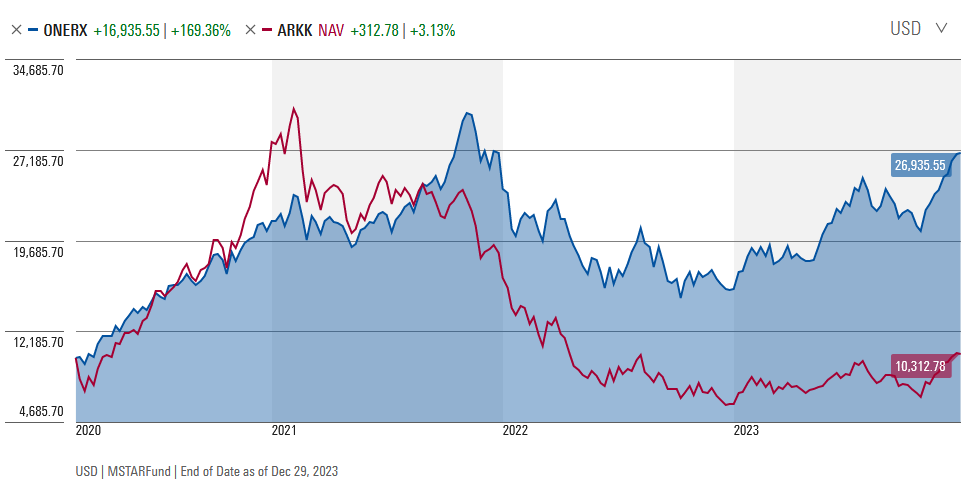Since the number of funds we can cover in-depth is smaller than the number of funds worthy of in-depth coverage, we’ve decided to offer one or two managers each month the opportunity to make a 300-word pitch to you. That’s about the number of words a slightly manic elevator companion could share in a minute and a half. In each case, I’ve promised to offer a quick capsule of the fund and a link back to the fund’s site. Other than that, they’ve got 200 words and precisely as much of your time and attention as you’re willing to share. These aren’t endorsements; they’re opportunities to learn more.
One Rock Fund (ONERX) launched on March 6, 2020, the only public offering by – and only client of – Wrona Investment Management of Pinehurst, NC. The firm was founded by, and the fund is managed by, Jeff Wrona.
 If Jeff’s name is familiar to you, you’ve either got a long record as an investor and a good memory, or you’re a market historian.
If Jeff’s name is familiar to you, you’ve either got a long record as an investor and a good memory, or you’re a market historian.
Jeff was last prominent in the 1990s as one of the guys who most effectively exploited the dot-com bubble as a manager, first, for Munder (1990-97) and then for PBHG (1997-2001). In the latter post, he was responsible for managing over $10 billion in assets in funds such as PBHG Technology & Communications and PBHG Core Growth funds. He, more than most, experienced both the era’s highs (up 240% one year) and lows (down 44% another).
For personal reasons, he left PBHG and the world of professional investment management in 2001. Life got rocky, then life got better. After an 18-year hiatus, during which he invested his family money, he launched One Rock Fund. The fund’s name reflects his profound personal religious conviction. The fund’s homepage begins with the reflection, “I hope ONE ROCK Fund will be a blessing to others as we have been blessed.”
One Rock invests in the stocks of corporations with “business momentum.” That’s entirely distinct from stock momentum; he’s looking for accelerating companies. Here’s a description of the investment process:
a bottom-up, fundamental research approach to each company and industry with a technical analysis overlay to gain a better understanding of investor sentiment and potential future risks. The Adviser expects that many, or possibly all, of these companies, will be in the technology sector and exhibit strong growth in revenues, earnings, and/or cash flows, although significant investments may also be made in other sectors.
The fund also excludes companies “involved in the production or wholesale distribution of alcohol, tobacco, vaping equipment, gambling equipment, gambling enterprises, pornography, or which provide products or services that do not allow the right to life at all stages.” (The use of index futures might indirectly expose investors to those industries.) The portfolio currently holds about 50 stocks, with an exceptionally high turnover ratio that might make it most appropriate for a tax-sheltered account. Jeff uses futures and options to fine-tune both market exposure and to hedge position risk. Those derivatives helped a bit in 2022 and held back performance a bit in 2023.
How have those 30 years of experience manifested themselves in an investor’s portfolio? Jeff and I chatted about that very question in December 2023.
My wife keeps chiding me that I’m the worst marketer for my own fund that I can be. Still, I’ll try to explain how that experience serves as a differentiator.
2022 – remember, I’ve been investing for over 30 years – out of all those years, last year was one of my best years ever in terms of decision-making and actions taken. 2008 helped me tremendously because I lived through that history, I didn’t just read about it in an MBA class. The first five days of 2022 and the end of 2021 felt a lot like the first 5 days of 2008 and the end of 2007. In the end, for aggressive growth stocks, 2022 was worse than 2008. I was called to remembrance, got defensive. Raised some cash. Got out of our long futures. Layered out short call options. We were net 70% invested in parts of 2022.
A lot of our peers were down 50 or 60% last year. With a 60% drawdown, they need a 150% return to get back to zero. We drew down 42% and needed 72.5% to make it up. As of today, we’re there. Not a lot of the fundamentals changed between 2022 and 2023; the difference (between a 40% loss and a 70% gain) is sentiment triggered by interest rate fears.
Since inception, the fund has returned an average of 29.4% annually (through 11/30/2023, per MFO Premium). That is more than double the return of its Lipper multi-cap growth peers.
Comparison of Lifetime Performance (04/2020 – 11/2023)
| APR | Max drawdown | Standard dev | Downside dev | Ulcer Index | Sharpe Ratio | Sortino Ratio | Martin Ratio | |
| One Rock | 29.4 | -42.0 | 32.2 | 18.9 | 20.5 | 0.86 | 1.46 | 1.35 |
| Multi-Cap Growth Ave. | 14.6 | -37.1 | 23.8 | 14.6 | 19.6 | 0.57 | 0.96 | 0.87 |
The fund is 3.7 years old, so the maximum timeframe for a detailed comparison at MFO Premium between One Rock and its 124 fund and ETF peers is the past three years. In that time, One Rock has returned 11.2% annually, fourth among all 125 multi-cap growth funds. Its volatility is substantially higher than its peers (32% versus 22%) but its returns have been so much stronger that its risk-adjusted returns, measured by its Sharpe ratio, dwarves its peer average (0.28 vs -0.04) and place it in the top 20 of all multi-cap growth funds.
The more famous of the deeply faithful tech investors is Cathie Woods, whose ARK Investments were named after the Ark of the Covenant, and whose ARK Innovation ETF is roughly 6oo times larger than One Rock. If one had committed $10,000 to ARKK on the day ONERX launched, your portfolio today would be worth $10,313 (though your antacid bill would be substantial). If you had committed the same $10,000 to ONERX, you’d be sitting on $26,936 today, well over double with far fewer thrills.
It is, in short, a very strong performer. Nonetheless, there are already 125 other funds fishing the same waters, leading to the question “Did we need fund #126?” Does One Rock really offer an opportunity not found elsewhere? Rather than guess, we put the question to Mr. Wrona: “If you happened to find yourself in an elevator with a curious if slightly skeptical potential investor, how would you answer their reasonable question, ‘Why would I want to think about One Rock?’” Here are his 242 words in response:
Ideally, who would you want managing your money?
You’d want someone with a long history of investing in the stock market, like 30+ years.
You’d choose someone who is available and acts when stocks move the most, which is when new information comes out, including corporate earnings. Almost all of this happens before the market opens at 9:30 am, or after the market closes at 4:00 pm EST.
You’d want someone who is nimble and can move in and out of stocks quickly. So ideally, someone who is managing a smaller amount of money rather than larger, because someone managing $10 billion will most likely not perform as well as that same person managing $100 million, because they can’t move the money as fast. Larger assets are usually a hindrance to stronger results.
You definitely want someone who has all their financial investments right alongside yours, and so they show through their actions, what they believe to be the best possible investment.
Most importantly, if you’re a follower of Jesus, the Christ, you want the person investing your money to be like minded; someone who believes in the One so unmovable and so unshakable that when times of turmoil come, and they will, that they are unwavering.
And finally, all this would have to be evident through a strong track record of financial success. One Rock Fund, and the person who manages it, has all the things you’re looking for. Here’s my business card.
 One Rock Fund (ONERX) has a $2,000 minimum initial investment. It is available only through direct purchase from the adviser. The fund charges 1.75% on assets of about $15 million. (Yes, that’s not Walmart pricing but with a 1% management fee Mr. Wrona is not getting rich running this fund for you.) The fund has seen small, consistent inflows across the years. One of the charms of a boutique fund is that Mr. Wrona sees each purchase and redemption request and, at the end of 2022 when investors were anxious, took time to call some of his investors to talk with them about their concerns. Some, he reports, chose to stay (and enjoyed a gain of over 70% in 2023) while some still chose to go.
One Rock Fund (ONERX) has a $2,000 minimum initial investment. It is available only through direct purchase from the adviser. The fund charges 1.75% on assets of about $15 million. (Yes, that’s not Walmart pricing but with a 1% management fee Mr. Wrona is not getting rich running this fund for you.) The fund has seen small, consistent inflows across the years. One of the charms of a boutique fund is that Mr. Wrona sees each purchase and redemption request and, at the end of 2022 when investors were anxious, took time to call some of his investors to talk with them about their concerns. Some, he reports, chose to stay (and enjoyed a gain of over 70% in 2023) while some still chose to go.
The fund’s homepage is modest but easy to navigate.










